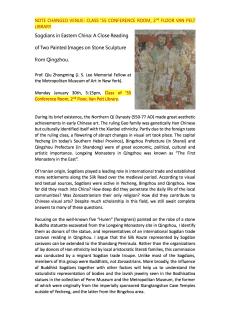Event

During its brief existence, the Northern Qi Dynasty (550-77 AD) made great aesthetic achievements in early Chinese art. The ruling Gao family was genetically Han Chinese but culturally identified itself with the Xianbei ethnicity. Partly due to the foreign taste of the ruling class, a flowering of abrupt changes in visual art took place. The capital Yecheng (in today's Southern Hebei Province), Bingzhou Prefecture (in Shanxi) and Qingzhou Prefecture (in Shandong) were of great economic, political, cultural and artistic importance. Longxing Monastery in Qingzhou was known as "The First Monastery in the East".
Of Iranian origin, Sogdians played a leading role in international trade and established many settlements along the Silk Road over the medieval period. According to visual and textual sources, Sogdians were active in Yecheng, Bingzhou and Qingzhou. How far did they reach into China? How deep did they penetrate the daily life of the local communities? Was Zoroastrianism their only religion? How did they contribute to Chinese visual arts? Despite much scholarship in this field, we still await complete answers to many of these questions.
Focusing on the well-known five "Huren" (foreigners) painted on the robe of a stone Buddha statuette excavated from the Longxing Monastery site in Qingzhou, Professor Qiu Zhongming identify them as donors of the statue, and representatives of an international Sogdian trade caravan residing in Qingzhou. He argues that the Silk Route represented by Sogdian caravans can be extended to the Shandong Peninsula. Rather than the organizations of lay donors of Han ethnicity led by local aristocratic literati families, this commission was conducted by a migrant Sogdian trade troupe. Unlike most of the Sogdians, members of this group were Buddhists, not Zoroastrians. More broadly, the influence of Buddhist Sogdians together with other factors will help us to understand the naturalistic representation of bodies and the lavish jewelry seen in the Bodhisattva statues in the collection of Penn Museum and the Metropolitan Museum, the former of which were originally from the imperially sponsored Xiangtangshan Cave Temples outside of Yecheng, and the latter from the Bingzhou area.
Professor Qiu Zhongming is J. S. Lee Memorial Fellow at the Metropolitan Museum of Art in New York.